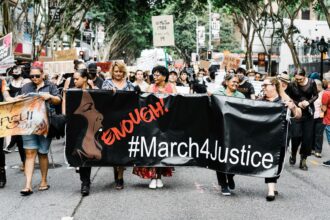Here’s Anayat Ali Shotopa’s Revival of Mamani Festival’s Remarkable Cultural Resurgence in Kargil
In the picturesque region of Kargil, nestled within the folds of the Himalayas, a vibrant cultural renaissance is underway through the spirited revival of the Mamani Festival, led by the indefatigable local activist, Anayat Ali Shotopa. The festival, steeped in the celebration of transitioning from winter to spring, had dwindled in prominence until Anayat Ali Shotopa, spurred by a fervent desire to preserve the region’s rich cultural tapestry, initiated its resurgence in 2016.
The Mamani Festival, renowned for its celebration of culinary heritage and community bonding, faced a decline in its essence and prominence over the years. Recognizing the perilous fade of this cherished tradition, Anayat Ali Shotopa mamarshalledhe collective enthusiasm of his kin and friends to resurrect the festival’s splendour
“Preserving our cultural essence was paramount to prevent our treasured culinary delights and age-old traditions from fading into obscurity,” articulated Anayat Ali Shotopa, emphasizing the critical importance of safeguarding Kargil’s rich cultural heritage.
What began modestly at Tha Tha Khan ni Chagrah (Old SRTC Stand) in Kargil in 2016, soon burgeoned into a jubilant celebration extending beyond geographical boundaries. From a humble offering of nine traditional dishes in 2016, the festival has blossomed, showcasing a grandiose array of 35 culinary delights by 2023. This transformation stands as a testament to the unwavering commitment and collective endeavour of the community to preserve its astronomical legacy.
Anayat Ali Shotopa’s visionary leadership propelled the festival’s expansion across diverse locales, transcending its once-constrained boundaries in Kargil Town to encompass Shargole, Chiktan, and the Heritage Village of Styangkung. This geographical outreach has fostered a sense of unity and shared heritage, echoing the vibrant cultural resonance that permeates through the Himalayan valleys.
Yet, Shotopa’s ambitions soar higher. His aspirations extend beyond mere celebrations, aiming to embed the Mamani Festival firmly within the tourism calendar. His vision is to showcase Kargil’s cultural vibrancy and gastronomic opulence to a broader global audience.
“It’s not just about Mamani; it’s about rejuvenating our cultural tapestry. We aspire to resurrect other festivals like Strublah, MindokGryaspa, and more, ensuring our heritage remains an indelible part of generations to come,” underscored Shotopa, elucidating his broader vision for safeguarding Kargil’s cultural legacy.
The Himalayan Cultural Heritage Foundation’s active involvement has further augmented the festival’s organizational finesse. Assumedly responsible for the festival’s coordination, this institutional partnership has significantly bolstered Anayat Ali Shotopa’s efforts in unifying communities and celebrating Kargil’s rich heritage through the Mamani Festival.
Anayat Ali Shotopa reminisces about the festival’s evolution, cherishing its journey from an independent organization to finding a steadfast home under the Himalayan Heritage Foundation’s cultural revival banner.
The festival’s metamorphosis symbolizes not just a celebration but a communal commitment to safeguard and cherish the cultural richness embedded within the heart of Kargil.
As the Mamani Festival continues to flourish under the Himalayan Cultural Heritage Foundation’s programme, Silk Route Initiative Ladakh, it embodies the spirit of collective collaboration and steadfast dedication to preserving the region’s cultural traditions. Anayat Ali Shotopa’s unwavering vision and tireless efforts serve as an inspiration, illuminating the path towards safeguarding Kargil’s cultural heritage for posterity.
If you also wish to be part of the next Mamani festival or know more about it do reach out to Anayat Ali Shotopa.
Contact number: 94198 21562
Date: 21 January, every year
Meeting Anaya Ali Shotopa and Sadiq Hardassi In Kargil
I had the privilege of meeting Anayat Ali and Sadiq Hardassi sir through Sonam Wangchok sir in Kargil in the month of December 2024. We sat together and spoke at length about historical significance, cultural diversity and the feeling of being oneness in spite of differences in religious affiliations. I listened to Sadiq Hardassi sir like a curious student to the painful, yet inspiring stories of divided families between India and Pakistan.
On the spine chilling night, the locals were kind enough to invite us over for dinner and I was overwhelmed by love and hospitality.
The food served for dinner was “Wazwan” which is the most popular dish in Kashmir.
I was taken aback seeing Wazwan in Kargil, it was then Anayat explained the influence of Kashmir in Kargil including cuisine.
During dinner Anayat invited us for a local Local Purgi Breakfast (Nangzan) at his residence in Goma Kargil the next day. We felt so loved and next morning once we reached Anayat’s house we were welcomed by the local customary way and served with an elaborate spread of breakfast consisting of local food items. Anayat and Sonam sir were kind enough to explain the names and the significance of each food item.
Thanks Anayat bhai, words fell short to describe the love and hospitality you showered upon us. With a promise to visit again and again and continue to work in the promotion of Kargil, I signed off from Kargil.
Local Purgi Breakfast (Nangzan) Breakfast at Anayat’s residence
Traditional way of enjoying Local Purgi Breakfast (Nangzan)
Namkeen Chai or Noon Chai
hRsab Khur made baked in Ash
hSkuri Taki (Bread) made in Chullah
Buckwheat PanCake(Poli)
Local Achar made with organic carrots, cabbage, spinach, With herbs and masala
hRsab (Traditional Sweet made of Flour of Sprouted Barley or Wheat) Made with modern touch in Pressure Cooker
hRsab (Traditional Sweet made of Flour of Sprouted Barley or Wheat)
Local Apricot from Kargil
Chuli (Apricot with Pure Desi Milk Cream)(My own recipe by Anayat and he has named it Apricot Cream Sometimes served with stuffing fruits and dry fruits)
Pure Desi Milk Cream
Chattani Curd mixed with Local Mint (Phopholing)
Seabuckthorn Juice
Serving namkeen chai- Anayat’s brother
Bukhari (Wood is used to heat and warm)
Local kids at Anayat’s place
The following people without whose help and support this journey to Kargil from Leh wouldn’t have been possible:
Dr. Sonam Wangchok is one such dedicated, hardworking, compassionate, and selfless son of Ladakh who has devoted his life for the preservation of his slow-losing culture and to protect the identity of his people. He is a cultural activist, independent researcher, social worker and one person instrumental in preserving cultural legacy of the Himalayas
Anayat Ali Shotopa, a Copy Editor at Akshwani Regional News Unit in Kargil, holds an MBA in Tourism Marketing from TBS Jammu University. He is passionate about preserving cultural heritage and have organized a seminar in collaboration with CIBS Leh to revive the Prugi Script (Egay).
His dedication lies in both editorial work and promoting tourism through effective marketing strategies.”
Sadiq Hardassi, a school teacher by profession, scholar and an academician with profound knowledge of Ladakh and special interest in Divided Families between India and Pakistan.




